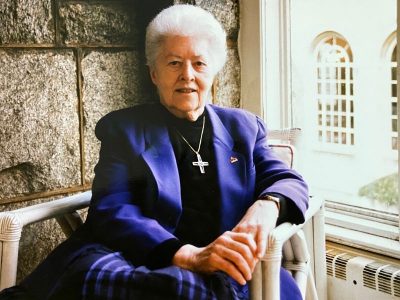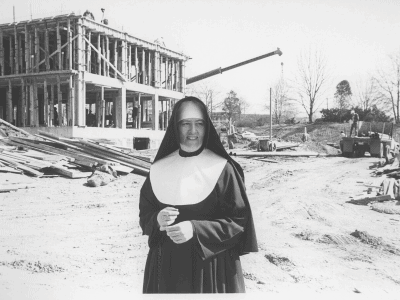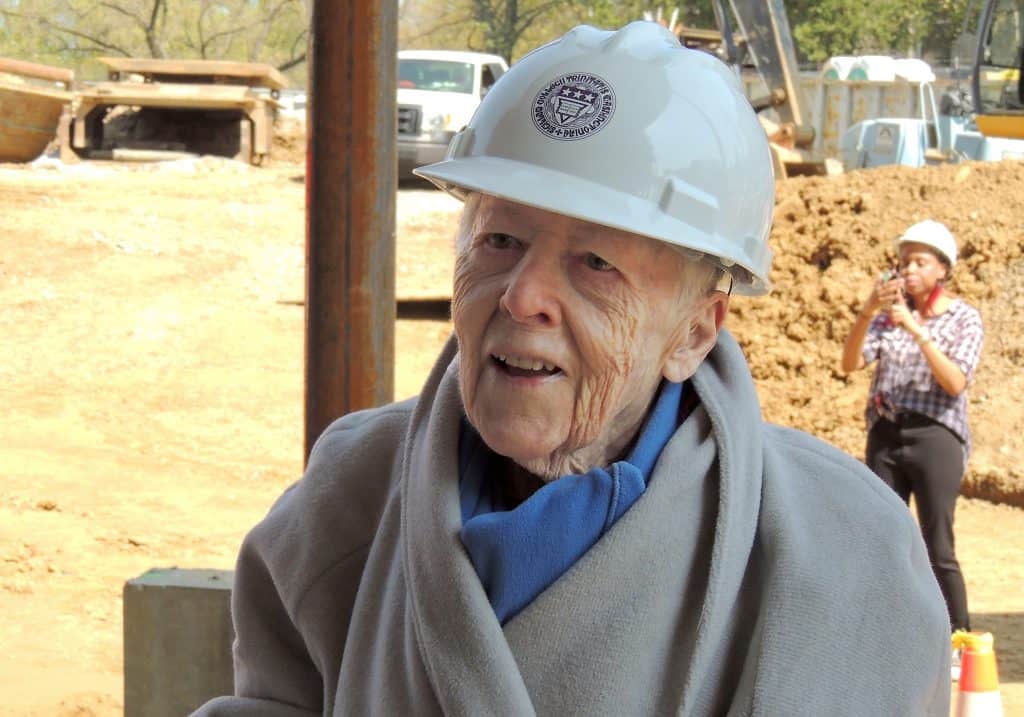
Sister Margaret: Our Muse, Our Inspiration, Our Guide
 It was my distinct honor and privilege to offer these reflections at the Mass of the Resurrection for President Emerita Sr. Margaret Claydon, SND:
It was my distinct honor and privilege to offer these reflections at the Mass of the Resurrection for President Emerita Sr. Margaret Claydon, SND:
Today’s beautiful liturgy is a magnificent celebration of the life of our beloved Sister Margaret Claydon, with many thanks to Father Rich Colgan and the Paulists, and Campus Minister Sr. Ann Howard, SND, and Sacristan Christina Joliffe.
Kathy Claydon Lightfoot, Kathy Keefe, members of Sister Margaret’s family, Sisters of Notre Dame and members of the Trinity community, alumnae, faculty and staff and students: thank you for being part of this great celebration of a remarkable life, an intrepid spirit, a woman who inspired all of us to “proclaim ideals that never swerve” in the words of Trinity’s alma mater.
Beautiful tributes, so many memories, have poured into Trinity this week – hardly a person who traversed Trinity’s campus or knew a member of the vast Trinity family across the last 75 years escaped the powerful, penetrating influence of Sr. Margaret Claydon — college president, Hopkins scholar, Shakespeare teacher, faculty colleague, national educational leader, classmate, friend, mentor, religious sister, woman of great intellect and faith. As one alumna wrote, she was the embodiment of Trinity’s motto Scientia Ancilla Fidei, Knowledge the Servant of Faith.
As I reflected on the tributes and shared stories with callers and heard the voices of our great Trinity family mourn and remember, I realized that I did not need to do much to prepare this reflection other than to let the voices of Trinity speak in the grand chorus of memory and gratitude for having the grace of Sr. Margaret in our lives. The words of Trinity alumnae across the decades speak to us this morning in a remarkable litany of praise for our Trinity sister:
- An exemplar of the ideal Trinity Woman
- A leader of penetrating intellect
- A symbol of women’s strength and empowerment
- A transformational leader
- Intellectual and elegant
- Courageous
- Majestic, magnificent
- Great character, wisdom, intelligence and grace
- Dignity
- Indomitable
- Formidable
- Visionary
- A friend, a classmate, a role model, a mentor
- Erudite and charming
- Best of the best
- Compassionate soul
- Gracious and classy
- Our muse, our inspiration, our guide to higher realms (thanks to Cynthia Russell ’81 for this phrase, which I borrowed for the title of this reflection)
Each of us, in our own way, have insights and reflections on Sister Margaret’s life, work and legacy depending on how we experienced our relationship with her as students, colleagues, sisters in community, family and friends; over time, for some of us, our relationship changed as we grew and took on new roles. Louise Hallahan Stakelin and alumnae in Cincinnati extended particularly deep friendship to Sister Margaret when she moved to Mount Notre Dame, — so many thanks to Louise and Susan Tew and Kathryn Harsh and other alumnae there —- and Louise had a reflection that speaks to something many of us experienced in our own relationships with Margaret: “It’s hard for me to describe how you can revere and admire someone for so many years and much later on have the enormous blessing of becoming a close friend.”
So it was that the Sister President I knew and admired, albeit often from afar in my student days, and, I confess, sometimes as her tormentor back then, became my confidante, mentor, trusted guide and friend as I learned how to be Trinity’s president.
In this role, at times, there are very few people in whom a president can confide honestly about the challenges we face. She instinctively knew what I was worrying about whenever she stopped by the office. When students would trouble me with various antics, I told her I felt like I was paying for the sins of my youth, and she would smile that small wry smile and chuckle appreciatively. She always wanted to know about visits I had with alumnae, and she conspired with me about how to solicit the large charitable gifts — “the biggies” as she called them — we needed to secure Trinity’s future. We went together several times to visit with the great Mary Goubeau whose legacy for Notre Dame Chapel is a testament to Sister Margaret’s stewardship.
 As I delved through the records of her presidency, I gained deep appreciation of her bold plans for Trinity — she loved building projects, first building the music and art wing of Main Hall, then building the library and Kerby Hall, then purchasing the Soldier’s Home property across the street! Planning to build a campus on both sides of Michigan Avenue! Suggesting to the city that Michigan Avenue should be closed because after North Capitol Street was cut through above Michigan there was hardly any traffic on Michigan!! — No small thinking for Sister Margaret! It was 1966, a simpler time traffic-wise in the city, and her campus master plan was magnificent!
As I delved through the records of her presidency, I gained deep appreciation of her bold plans for Trinity — she loved building projects, first building the music and art wing of Main Hall, then building the library and Kerby Hall, then purchasing the Soldier’s Home property across the street! Planning to build a campus on both sides of Michigan Avenue! Suggesting to the city that Michigan Avenue should be closed because after North Capitol Street was cut through above Michigan there was hardly any traffic on Michigan!! — No small thinking for Sister Margaret! It was 1966, a simpler time traffic-wise in the city, and her campus master plan was magnificent!
And then, and then… in 1968, just weeks after the president of Georgetown assured her they would not go coed, she picked up the Washington Post to read the announcement of coeducation at Georgetown. Washington burned that year in the aftermath of Dr. King’s assassination, and then the student anti-war protests came to town, and then the great law for women’s right Title IX enticed women to the big universities, and suddenly Trinity’s remarkable growth began to slow. But Sister Margaret, ever the bold leader and champion of women’s education, pressed on in the belief that Trinity, the nation’s first and best Catholic women’s college could, indeed, must persist and thrive in service to our nation and world. She held fast to the belief she stated in a Time magazine interview when she became president in 1959, that “We’re not in the business of training committee women or bridge players,” but rather, educating public intellectuals who have ideas to contribute to improving society.
Trinity is still a Catholic women’s college today, first and foremost, because Margaret Claydon would not give up on this critically important mission that is increasingly rare in a world dominated by large, homogenized universities. There are only seven such institutions still operating, down from a high of about 170 in 1960. Like most of the remaining seven, we are a diversified university today with coed graduate and professional programs, but Trinity College, our women’s college, remains the foundation and true heart of Trinity Washington University. Our choice to sustain Trinity College to meet the educational needs of women who need this education so very much is deeply rooted in the vision, courage and philosophy of Sister Margaret Claydon, who emulated Trinity’s founders Sisters Julia McGroarty and Mary Euphrasia Taylor in her devotion to this mission, to make a great higher education accessible to women who need it, and St. Julie Billiart’s call to her sisters to “teach them what they need to know” to thrive.
 Sister Margaret helped me immeasurably to think through our large plans for campus development, drawing upon the work she did in the 1960’s. She was thrilled when we finally were able to open the athletic center she long desired, and she was a regular for a long time at the Fitness Center. The academic center was another fulfillment of plans she laid so long ago. As construction ensued on the Payden Center, she often walked over to watch the work progressing on that site, and even put on a hardhat for the topping-off party.
Sister Margaret helped me immeasurably to think through our large plans for campus development, drawing upon the work she did in the 1960’s. She was thrilled when we finally were able to open the athletic center she long desired, and she was a regular for a long time at the Fitness Center. The academic center was another fulfillment of plans she laid so long ago. As construction ensued on the Payden Center, she often walked over to watch the work progressing on that site, and even put on a hardhat for the topping-off party.
Trinity in 2020 faces many of the same challenges that Sister Margaret faced in the 1960’s — not only in strategic business terms, which are constant, but more importantly in grounding the relevance of our mission in meeting the needs of our times. I read each day some new call to turn away from the liberal arts, even questioning the whole value of a college degree, and then I re-read her words from the speeches and reports she gave 50 years ago, words that are so powerful, so insightful and still urgent. Consider this excerpt from her 1965 speech “Inheriting a Revolution” which is truly a manifesto for why the world needs Trinity to thrive:

“One of the basic rights of free man [person] is to be informed truthfully about public events. Our students must be taught from the very beginning that this right is theirs, that they have a duty to seek the facts, the right to investigate truth freely… For the times in which we live, rigidity or timidity have no place. These times, these problems cry out for courage, for openness.…We have to encourage our students …to take stands that may be unpopular, that may even expose them to ostracism, debate, controversy… These must be the hallmarks of educated people …”
That truth from 1965 is even more important today.

Sister Margaret’s magnificent achievements are summarized in the many stories about her this week, but her life and work truly are deserving of a much deeper and richer biography. Among her many achievements — establishing our Phi Beta Kappa Chapter, creating the MAT program for local teachers, leading ecumenical dialogues, modernizing the curriculum and student life, while also contributing in numerous ways to work for the Sisters of Notre Dame — Margaret was also a national educational leader not only for women’s education but for Catholic education.
She was president of the National Catholic Education Association in 1965, and in that position she was a powerful advocate for bringing lay leadership onto boards of trustees, a feat she accomplished at Trinity in 1968. She was the only woman on a delegation of U.S. Catholic college presidents to the Vatican in 1972, and she loved to tell the story of how Father Ted Hesburgh of Notre Dame made sure that the men knew that she was a voice that needed to be heard.
She was an invaluable advisor to me on issues in our relationship with the bishops, and several times she accompanied me to dialogues with local Catholic presidents and our cardinals on the topic of Ex Corde Ecclesiae, the 1990 Vatican document on Catholic higher education. I loved hearing her quiet but powerful her voice in those meetings — whenever she spoke, the clerics would actually stop talking and pay close attention to her, nodding in agreement, and I knew well enough to keep my own counsel and bask in her gloriously cogent explication of the ways in which our strength lies in being faithfully Catholic and academically independent.
Thanks to Sister Margaret, generations of Trinity Women will never get TS Eliott out of our heads:
“For I have known them all already, known them all:
Have know the evenings, mornings and afternoons,
I have measured out my life with coffee spoons.”
(T.S. Eliott, The Love Song of J. Alfred Prufrock)
or this:
“Time present and time past
Are both perhaps present in time future,
And time future contained in time past.”
(T.S. Eliott, Four Quartets)
She was, indeed, haunted by time, a phrase she used in a farewell poem she wrote to the students, faculty and staff of Trinity when she stepped down as president in 1975. As I started these remarks saying that none of my own words could surpass the deep reverence expressed by our alumnae, now I also must say that there is nothing I will ever write that can compare to Sister Margaret’s eloquent, elegant rhetoric. So today, let us hear her voice once more, in the farewell poem she wrote in 1975, reproduced in that year’s Trinilogue:
For Trinity Students and Faculty, April 13, 1975
Sister Margaret Claydon, SND
I am haunted by, harassed by
That relentless, sure-footed hunter, Time.
Tracking traces of my days
In scent of lilac and magnolia blooms,
Over waxen floors and chequered marble into innumerable meeting rooms
…
Along a trail of torn-up, now discarded words,
With echoes of the melodies of songs still half-heard.
The chase is narrowed now, channeled into blue-gold, green-red fountain
As you catch sight of them along a furrowed mountain.
Sniff them down, pursue them, you will find their print
Engraved upon the target of my heart.
Snared there, shimmering in memory’s fragile trap.
There I hold them, heap them —
A mass of minutes made of yesterdays…
My Trinity days.
Wrinkled Time, of implacable face,
Armed with your tick-tock arrows,
I defy you to erase
This measured, treasured, garnered harvest –
Ah, tell-tale hunter, harvester,
Memories mould me, fold me…
While I, with haggard, homing heart, elude
You, Old trapper Time,
In our enduring feud…
Prize of lover’s recollection,
Tenuous collection… My Trinity days.
As we leave with the memory of our Trinity days shaped and infused with the grace and spirit of Margaret Claydon, let us pray that the power, wisdom and love of the Most Holy Trinity remains with us and grows ever stronger thanks to her loving and constant devotion to our growth intellectually and spiritually in the great mission of Trinity.
1 Comment